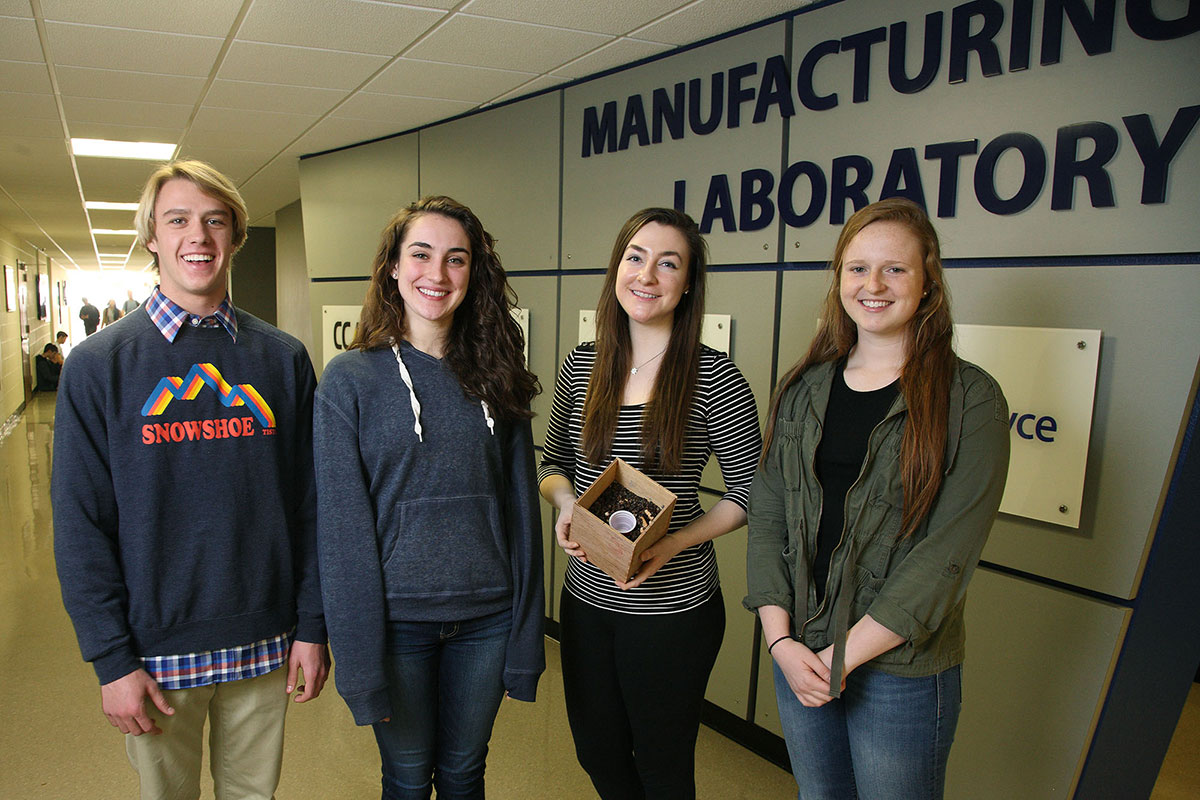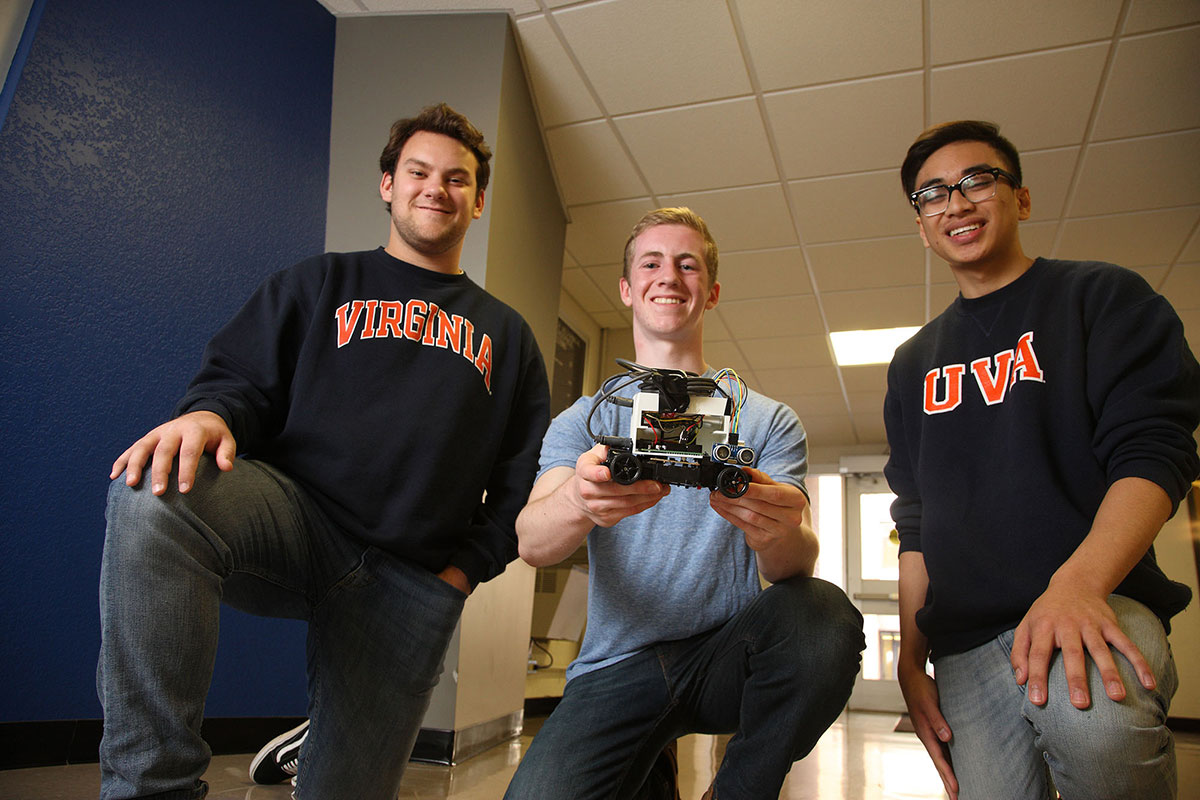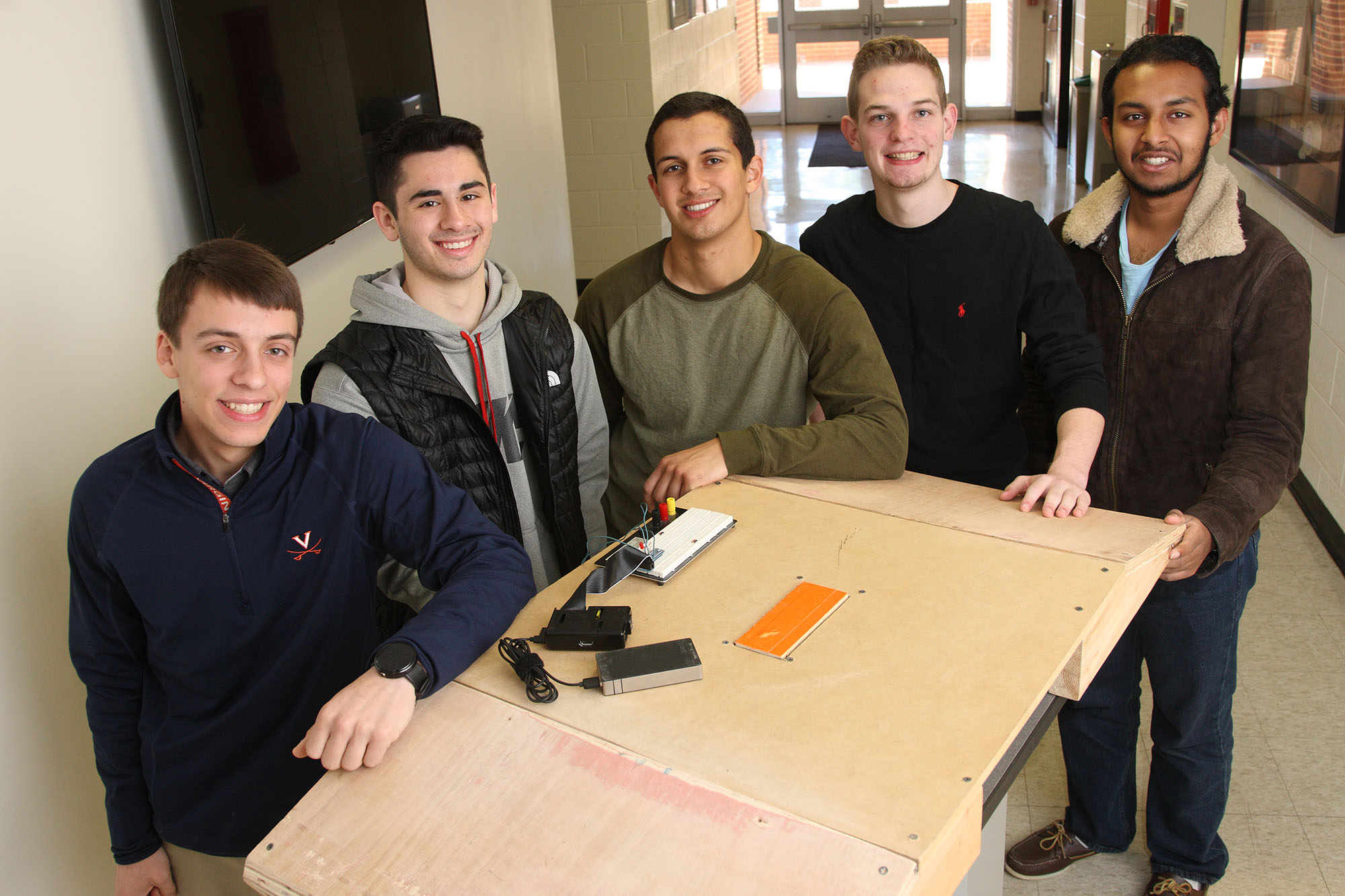One of the first things the student team noticed was the weight. How could a wheelchair-bound person possibly open the heavy, large doors in some of the older University of Virginia buildings, where power doors are not available?
After a day of wheeling around Grounds in a wheelchair to learn what it was like to navigate with a disability, members of team “Hoos Got Your Door” sprang into action. The group of first-year UVA engineering students brainstormed, tested and built a model for a pressure plate to be installed in the floor approaching a doorway.
The idea is that when a wheelchair glides over the pressure plate, the plate triggers a wireless Internet signal to open the door. People with disabilities also could download a free mobile app that would show them all the pressure plate-accessible doorways in a particular geographic area.
The concept drew praise from the team’s fellow first-year students in the School of Engineering and Applied Science’s “Introduction to Engineering” course. At UVA, all engineering students take this introductory course in their first year. A key feature of the course is that students are asked to collaborate on a project that could have real-world benefits.

From left, Justin Pender, Audrey Fifer, Caroline Kinsella and Morgan Patterson hold their mushroom spore home insulation, their project for their “Introduction to Engineering” course. (Photo by Tom Cogill)
“Coming into engineering, all you think about is building and designing,” said first-year student John Ruppert, a member of the “Hoos Got Your Door” team. “We learned about the impact you can make. And we realized that everything makes a difference to someone else.”
“Introduction to Engineering” takes students who were high-schoolers just a few months before and begins to transform them into University-level thinkers and creative problem-solvers who soon will be qualified to work in top engineering careers worldwide.
“In general, students have very little exposure to engineering before college,” Ann Reimers, a lecturer in the Department of Engineering & Society, said. “Through the hands-on work they do in ‘Introduction to Engineering,’ they gain a better understanding of how engineers contribute to society, what they work on day to day, and what role each discipline plays in the teamwork that goes into completing a successful engineering project. This allows them to make informed decisions about their major and get excited about what they can accomplish as an engineer.”
In Reimers’ section of the course, students build cantilevered hangers, such as those used in construction; the students are given specifications for the type and amount of material they can use, and they must try to maximize the hangers’ weight-bearing capacity within those specifications. The hangers are 3-D printed and then tested until they fail.
Students also custom-program “Sparkfun” robots to appeal to different audiences. Last semester, one team turned its robot into a remote-controlled mouse toy for cats; another created a sensor-driven cart that can be used in classrooms to collect student papers.
Lisa Colosi Peterson, a civil and environmental engineering professor, charged her students with identifying one consumer object that they could reverse-engineer and then “upcycle” into a second consumer object with a different use. They had two constraints: They had to use at least 75 percent of the original object in their second object; and the total budget for the design and prototype was $40.
One team turned a desk chair into a scooter. Another made an umbrella into a backpack. Another created a clothing steamer from a vegetable steamer.
All teams had to conduct a life-cycle assessment, which is an environmental accounting to compute direct and upstream energy use, water use, global warming potential and water-quality impacts. They also graded themselves by creating an effectiveness equation, taking into account design attributes and weighting. The winning project, based on its low cost and ease of use, was a flashlight transformed into a head lamp.
Keith Williams, a visiting assistant professor in the Electrical and Computer Engineering Department who teaches another section of “Introduction to Engineering,” said he thinks the violin represents a perfect engineering project, so he asks his students to design custom violins from cigar boxes and other simple parts. In December 2014, his students used their instruments to perform the “Good Ol’ Song” for UVA President Teresa Sullivan.
Team “Hoos Got Your Door” was in a section taught by Susan Donohue, a lecturer and coordinator of the “Introduction to Engineering” courses. Donohue tasked the class with brainstorming solutions to challenges of daily living faced by people with disabilities.
“Wheel Team 6” – Connor Stephens, Brandon Peck, Cesar Roucco, Kaitlyn Dostic, Kyle Jones and Rachel Seldowitz – developed a breakaway back support for wheelchairs, so people could simply slide out when transferring to another chair or a toilet seat, rather than having to stand and transfer. Other teams worked on a telescoping claw door opener, a wheelchair seat with a hydraulic lift, and a sensor that would detect distance to obstacles for people with sight impairments.
“‘Introduction to Engineering’ is the first time many first-years get a real introduction to engineering,” Donohue said. “Too many times, ‘engineering’ in K-12 is robotics. Students don’t necessarily get introduced to a model of the engineering design process in K-12, but they do here. It’s a way of thinking, of problem-solving. It’s also the first time many students have used tools. And it’s hands-on, project-based learning, which is one of the most effective active-learning pedagogies.”
Donohue also said that the course is now the vehicle by which the majority of School of Engineering first-year students receive their faculty advising.
“I personally like it, because I just don’t see my advisees once or twice a semester,” she said. “I see them three times a week and can do real-time advising.”
In another one of Donohue’s classes, students had to use bio-inspired design for their engineering projects – which means they had to develop a product that was based on biological principles, such as animal adaptations. One team, for example, created home insulation from mushroom spores.
Another team had a “eureka moment” when researching self-driving cars and bats. Oliver Viyar, Brady Madden and T. Coleman Goad wanted to design a car that would use ultrasonic sensors to detect obstacles and distances. Their echolocation car had to be compact, self-powered and self-driving. It took many long nights, many trials and many rewrites of computer codes.

T. Coleman Goad, Brady Madden and Oliver Viyar show off their self-driving car based on the principles of echolocation. (Photo by Tom Cogill)
“Persistence is key,” Madden said.
Media Contact
Article Information
February 18, 2016
/content/students-do-not-become-engineers-sitting-lectures

